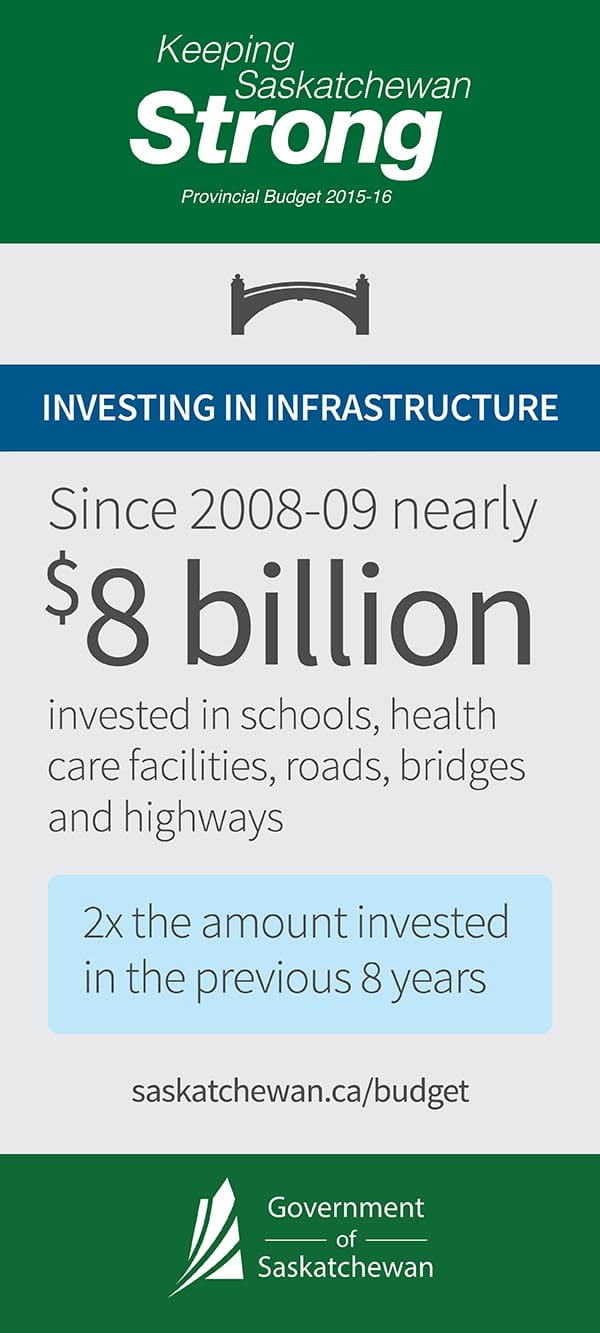Released on March 18, 2015
The Government of Saskatchewan is investing in seniors’ care, major capital projects, and in programs aimed at reducing emergency department wait times. This record investment of $5.12 billion in health care is an increase of $135 million or 2.7 per cent over 2014-15.“This budget places Saskatchewan’s patients first by investing in seniors’ care, reducing emergency department wait times, and investing in major capital projects,” Health Minister Dustin Duncan said. “First and foremost our aim is to continue to improve patient care in the health system, building on our government’s record of reducing surgical wait times and recruiting new doctors and nurses.”
Seniors’ care will be improved with an additional $10 million investment in new targeted funding to support seniors living in their own homes as well as improving the quality of long-term care. Highlights include:
- $3.5 million to support seniors who wish to remain at home as long as possible by enhancing the Home First/Quick Response Program in Regina Qu’Appelle, Saskatoon, and Prince Albert Parkland health regions and expanding the program in the Prairie North Health Region to an additional site. This brings the total funding for Home First/Quick Response to $8.0 million;
- $2.8 million in capital renovations in Regina Qu’Appelle Health Region and Saskatoon Health Region to develop specialized units for individuals with dementia or challenging behaviours;
- $2.0 million in individualized funding that provides increased choice and flexibility for home care clients to choose their care provider, providing more services and eliminating the current wait list for funding in the Five Hills, Prairie North, Regina Qu’Appelle and Saskatoon health regions;
- $1.0 million annually to support Purposeful Rounding, the practice of proactively seeing to the needs of long-term care residents within a prescribed amount of time, improving resident safety and satisfaction while improving quality of care, and
- $700,000 to develop a new Geriatric Program in the Regina Qu’Appelle Health Region, including the recruitment of a geriatrician to Regina, to provide a range of services to seniors, including support for quality in long-term care.

Capital investments in 2015-16 total $127.4 million, an increase of $32.5 million or 34 per cent from last year. Funding will support the construction of the 220 bed Swift Current Long-Term Care Facility and the Leader Integrated Care Facility, the completion of the new hospital in Moose Jaw and continued work on the Kelvington Integrated Care Facility.
A total of $27.8 million is targeted for critical infrastructure repairs in facilities across the province, an increase of $4.5 million from last year. The budget also commits $500,000 in new funding to the planning of a new hospital in Weyburn.
Regional Health Authorities will receive $3.3 billion for operating funding and for targeted initiatives. This funding is an increase of $55.7 million compared to last year, and supports care provided through hospitals, health centres and long term care facilities.
The budget also includes an investment of $4.7 million in programs aimed at reducing emergency department waits, an increase of $3.0 million. This funding supports a system-wide approach to reduce wait times in emergency departments by addressing root causes across the system.
“This initiative is about more than changing how emergency departments work – that’s just where the bottleneck occurs,” Duncan said. “To reduce emergency room wait times, innovative changes must be made in all points where people receive care.
Beginning this budget year, the Little Tots program, an Applied Behavioral Analysis program for pre-schoolers (2-5 years old) diagnosed with Autism will receive permanent, annualized funding of $550,000.
-30-
For more information, contact:
Tyler McMurchy
Health
Regina
Phone: 306-787-4083
Email: tmcmurchy@health.gov.sk.ca
